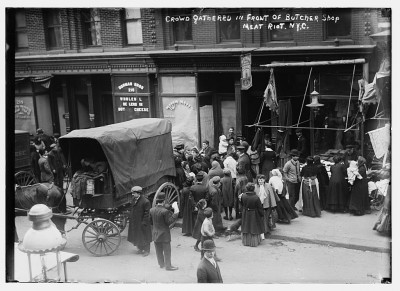Processions, Debates and Curbstone Encounters Part V

Article by Avi Y. Decter. Originally published in Generations 2011 – 2012: Jewish Foodways.
The boycott of 1910 was one dramatic episode in a twenty-year struggle over kosher meat that engaged meat wholesalers, retail butchers, shochets (ritual slaughterers), the Orthodox rabbinate, and thousands of ordinary Jews, especially in East Baltimore. In the first decades of the twentieth century, conflict over kosher meat was a familiar topic. Today, that contestation is little remembered and poorly documented. However, sufficient evidence survives to give us access to the trajectory and meaning of the protracted struggle over kosher meat. Here is that story.
Part V: The Community Responds
Missed the beginning? Start here.

Despite the surrender of the kosher butchers to the authority of the Orthodox rabbinate, agitation over the cost of kosher meat continued. The first week of October “several hundred delegates from various Hebrew societies in the city” convened a mass meeting to protest the rabbis’ decision that only locally slaughtered beef could be used by members of the Orthodox congregations to the exclusion of kosher meat shipped in from Chicago. Speakers at the meeting charged the rabbis with “an unwarrantable assumption of rights” that caused inconvenience and hardship to consumers. It was agreed to lodge a formal protest with the Orthodox Federation.[1]
That winter thousands of Jewish and non-Jewish Baltimoreans participated in a national boycott of all meat produced by “the Beef Trust,” both kosher and non-kosher. This national food protest began in Cleveland and spread quickly to other cities from New York to Des Moines. Protesters ranging from trade unions to suffragette organizations urged consumers of dressed beef, lamb, and pork to abstain from eating any meat for thirty to sixty days in an effort to force a drop in meat prices. Meanwhile, Congressional hearings were held in early 1910 to investigate charges that the cost of living was artificially inflated by the “Meat Trust” and others.[2]
Despite the success of the national boycott, kosher meat prices in Baltimore continued to rise. This time the retail butchers declined to boycott the wholesalers of kosher meat.[3] A mass meeting of Jewish housewives “denounced the butchers and wholesalers, whom they declared were in league together…Mrs. Sadie Cohen declared that no relief would be gained unless the butchers were punished. ‘Don’t you believe for one minute that the butchers are forced to raise the price. I say they are not,” said Mrs. Cohen in Yiddish.”[4] In a matter of days the “Kosher Meat War” was in progress.
Continue to Part VI: The “Kosher Meat War” of 1910
Notes:
[1] “Oppose Kosher Meat Compact,” Baltimore Sun, 4 October 1909, p. 11.
[2] “Meat Boycott Spreads,” Baltimore Sun, 22 January 1910, p. 1. “Women Urge the Boycott,” Baltimore Sun, 27 January 1910. “Hasn’t Heard Barons Squeal,” Baltimore Sun, 21 March 1910, p. 14.
[3] “Hasn’t Heard Barons Squeal.”
[4] “Kosher Meat Boycott,” Baltimore American, March 1910.
